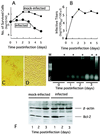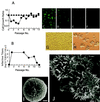Propagation of rat parvovirus in thymic lymphoma cell line C58(NT)d and subsequent appearance of a resistant cell clone after lytic infection
- PMID: 11264385
- PMCID: PMC114887
- DOI: 10.1128/JVI.75.8.3965-3970.2001
Propagation of rat parvovirus in thymic lymphoma cell line C58(NT)d and subsequent appearance of a resistant cell clone after lytic infection
Abstract
Rat parvovirus (RPV) is nonpathogenic in rats but causes persistent lymphocytotropic infection. We found that RPV was propagated in rat thymic lymphoma cell line C58(NT)D and induced apoptosis. Interestingly, a resistant subclone, C58(NT)D/R, from surviving cells after lytic infection had differentiated phenotypic modifications, such as increased cell adherence, resistance to apoptosis, and suppressed tumorigenicity.
Figures




Similar articles
-
Parvovirus nonstructural proteins induce an epigenetic modification through histone acetylation in host genes and revert tumor malignancy to benignancy.J Virol. 2005 Jul;79(14):8886-93. doi: 10.1128/JVI.79.14.8886-8893.2005. J Virol. 2005. PMID: 15994782 Free PMC article.
-
Spontaneous and induced apoptosis after whole body radiation exposure: experimental approaches. Observations in radio-induced thymic lymphomagenesis.Stem Cells. 1995 May;13 Suppl 1:129-35. Stem Cells. 1995. PMID: 7488938
-
Stages in the development of radiation-induced thymic lymphomas in C57 BL/Ka mice: preleukemic cells become progressively resistant to the tumor preventing effects of a bone marrow graft.Exp Hematol. 1997 Feb;25(2):109-13. Exp Hematol. 1997. PMID: 9015210
-
Correlation between reversion of a dedifferentiated rat hepatoma line and the recovery of tumorigenicity.Cancer Res. 1988 Jun 1;48(11):3258-64. Cancer Res. 1988. PMID: 3365704
-
Development of virus-accelerated thymic lymphoma in AKR mice.J Natl Cancer Inst. 1985 Sep;75(3):491-7. J Natl Cancer Inst. 1985. PMID: 3861900
Cited by
-
Through its nonstructural protein NS1, parvovirus H-1 induces apoptosis via accumulation of reactive oxygen species.J Virol. 2010 Jun;84(12):5909-22. doi: 10.1128/JVI.01797-09. Epub 2010 Apr 7. J Virol. 2010. PMID: 20375165 Free PMC article.
-
Human Retrotransposons and the Global Shutdown of Homeostatic Innate Immunity by Oncolytic Parvovirus H-1PV in Pancreatic Cancer.Viruses. 2021 May 28;13(6):1019. doi: 10.3390/v13061019. Viruses. 2021. PMID: 34071585 Free PMC article.
-
Retargeting of rat parvovirus H-1PV to cancer cells through genetic engineering of the viral capsid.J Virol. 2012 Apr;86(7):3452-65. doi: 10.1128/JVI.06208-11. Epub 2012 Jan 18. J Virol. 2012. PMID: 22258256 Free PMC article.
-
Lurking in the shadows: emerging rodent infectious diseases.ILAR J. 2008;49(3):277-90. doi: 10.1093/ilar.49.3.277. ILAR J. 2008. PMID: 18506061 Free PMC article.
-
Mechanisms of cell death in canine parvovirus-infected cells provide intuitive insights to developing nanotools for medicine.Int J Nanomedicine. 2010 Aug 9;5:417-28. doi: 10.2147/ijn.s10579. Int J Nanomedicine. 2010. PMID: 20957163 Free PMC article.
References
MeSH terms
LinkOut - more resources
Full Text Sources
Other Literature Sources
Medical
Research Materials

